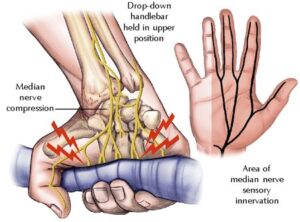“Rest and medications provide short-term recovery from cyclist’s palsy symptoms. However, exercises, changes in cycling habits, and the use of appropriate gloves and hoods are crucial for an effective cure.”
What is Cyclist’s Palsy? Understanding the Causes, Symptoms, and Complications
Cyclist’s palsy is an overuse injury that primarily affects your hands and fingers. It occurs when the nerves in your wrist or pinky side of the palm become compressed due to repetitive stress.
Some people may call it:
- Handlebar palsy
- Ulnar tunnel syndrome
- Ulnar nerve compression
- Guyon Canal Syndrome (GCS)
- Bicycler’s neuropathy
- Tardy ulnar palsy
Cyclist’s palsy can cause both motor and sensory symptoms. The motor symptoms can include weak hand grip and difficulty using fingers for precise tasks, whereas the common sensory effects include numbness, tingling, and pain.
 It is an increasingly common but often underreported overuse injury among cyclists. For instance, researchers found that 7 of 10 participants reported experiencing either motor or sensory symptoms in one study.1https://pubmed.ncbi.nlm.nih.gov/12860549/
It is an increasingly common but often underreported overuse injury among cyclists. For instance, researchers found that 7 of 10 participants reported experiencing either motor or sensory symptoms in one study.1https://pubmed.ncbi.nlm.nih.gov/12860549/
Though most cases improve with rest, exercises, and medications, some symptoms may persist for years after the initial injury. Besides, severe nerve injury may lead to paralysis or irreversible loss of sensations in the affected hand.
Unlike previously thought, cyclist’s palsy may affect both mountain and road bike riders. Most notably, you may be at a higher risk if you frequently ride stationary bikes for long periods.
Cyclist’s Palsy Treatment
Various cyclist’s palsy treatment strategies exist, ranging from rest to surgery. The selection of an appropriate option depends on the severity of the symptoms.
For example, rest and ice are enough, in most cases, for reducing nerve inflammation. Moreover, you may take OTC NSAIDs, such as ibuprofen or aspirin, to relieve inflammation.
Most notably, you should not resume cycling until your symptoms have significantly improved. If the OTC pain medications do not work, your doctor may prescribe more powerful NSAIDs.
Surgery to release pressure from the affected nerve is rarely necessary. Recovery from surgery can take up to six weeks, though bandages are removed within 24 hours, and stitches are taken out in about a week.
Other options to treat cyclist’s palsy can include:
- Occupational therapy
- Splints
- Steroid injections
- Cervical chiropractic manipulation
- Soft tissue therapy
Top 3 Cyclist Palsy Exercises
Exercises are essential for long-term recovery and avoiding recurrence. These exercises primarily help strengthen the muscles, ligaments, and tendons in your hands.
The best cyclist palsy exercises include:
- Finger bending exercise. To do this exercise, you should first stretch your hand. Then, bend the fingers of the affected hand at a right angle and hold them in the same position for about 10 seconds. While doing so, make sure your fingers are straight. Repeat 5 times.
- Finger squeeze. Squeeze a small object (for example, a coin or a sheet of paper) between two fingers and hold for 10 seconds. Do it 5 times for each set of fingers.
- Grip strengthening exercise. This is the best exercise for weak hand grip. Squeeze a rubber ball with the affected hand and hold for 10 seconds and then release. Repeat 10 times, and that’s one set. Aim for 3 sets of 10 as you gradually build up grip strength.
Going beyond the fingers
Riding in a hunched position for prolonged periods can irritate the nerve roots, causing pain and weakness in your hands. Thus, neck exercises should be a part of the comprehensive exercise program.
Likewise, you should consider wrist exercises, as having a strong wrist minimizes the risk of symptoms associated with cyclist’s palsy.
Neck exercises
Stand in an upright position and perform each of the following exercises for at least 10 seconds. Ensure that your movements are smooth and slow. Repeat these exercises several times a day.
Forward tilt
Stand straight with your back straight. Lower your chin forward as much as possible and hold for 10 seconds. Then, release and slowly lift your head to the neutral position.
Backward tilt
Lift your chin towards the ceiling and bring the back of your head towards your upper back. Hold for 10 seconds. Then, return to the start position.
Side Tilt
Gently bend your head towards your left shoulder and try to touch it with your ear. Avoid raising your shoulder. Stop when you feel you can no longer turn your neck. Hold 10 seconds and get back to the start position. Repeat on your left side.
Wrist exercises
Place your forearm with your palm down on a table. Your hand and wrist should be extended beyond the table. Now clench your fingers to form a fist while you gently bend your wrist upward and backward. Repeat 10 to 15 times.
Tips to Improve and Prevent Cyclist’s Palsy
- Lower and shift your seat backward to reduce stress to the arms and hands.
- Change your hand position frequently.
- Wear gloves with padding.
- If you frequently ride on indoor stationary bikes, use HIZE hoods to stay relaxed and minimize the risk of overuse injury.

HIZE Hoods
Hize Hoods are scientifically designed to help you get the most of your indoor cycling experience while significantly reducing the risk of injuries. The premise behind the design of the HIZE hoods is to offer an option for a better hand position on stationary bikes and help the rider experience a neutral hand/wrist angle. This relaxed hand position also allows for a natural bend int he elbows and less strain in neck/shoulders/lower back.
Have questions about cyclist palsy? Speak to Sports Specialized Provider within minutes for $29.
 How severe is your injury? Do I need to see a doctor or can this be managed at home? What should be my treatment plan? SportsMD Virtual Urgent Care is available by phone or video anytime, anywhere 24/7/365. Learn more via SportsMD’s Virtual Urgent Care Service.
How severe is your injury? Do I need to see a doctor or can this be managed at home? What should be my treatment plan? SportsMD Virtual Urgent Care is available by phone or video anytime, anywhere 24/7/365. Learn more via SportsMD’s Virtual Urgent Care Service.
FAQ’s
How long does a cyclist’s palsy last?
While this is a temporary problem, some symptoms may last up to eight weeks or even longer. If your symptoms persist or worsen, seek professional medical help.
How can cyclist’s palsy be prevented?
- Wear cycling gloves.
- Lower and shift your seat backward to reduce stress to the arms and hands.
- Change your hand position frequently.
- Make sure the bicycle properly fits your riding behaviors.
What causes cyclist’s palsy?
Also called handlebar palsy, it occurs when persistent stress on the nerves in your wrist or hand causes them to become irritated or inflamed.
Damn you cyclist palsy! I just want to use my hand again! This is the closest my fingers get together. #rtccto pic.twitter.com/45rIqQsg2p
— Laura Fox (@foxorama08) June 13, 2016
References
- Patterson, J Megan M et al. “Ulnar and median nerve palsy in long-distance cyclists. A prospective study.” The American journal of sports medicine vol. 31,4 (2003): 585-9. doi:10.1177/03635465030310041801.
